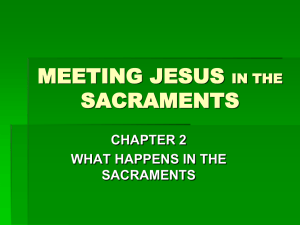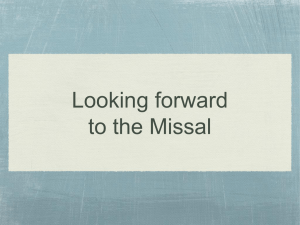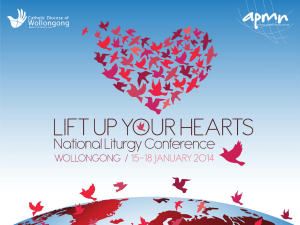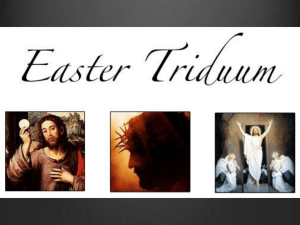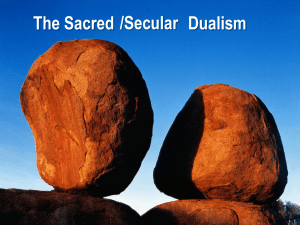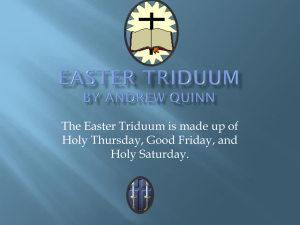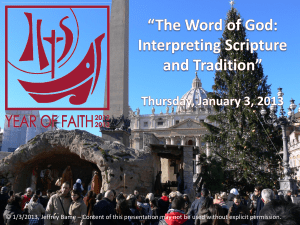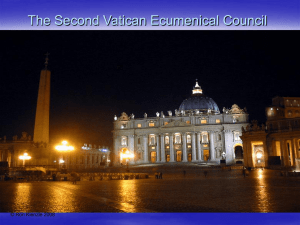What is liturgy? - St. Mary of the Miraculous Medal Catholic Church
advertisement
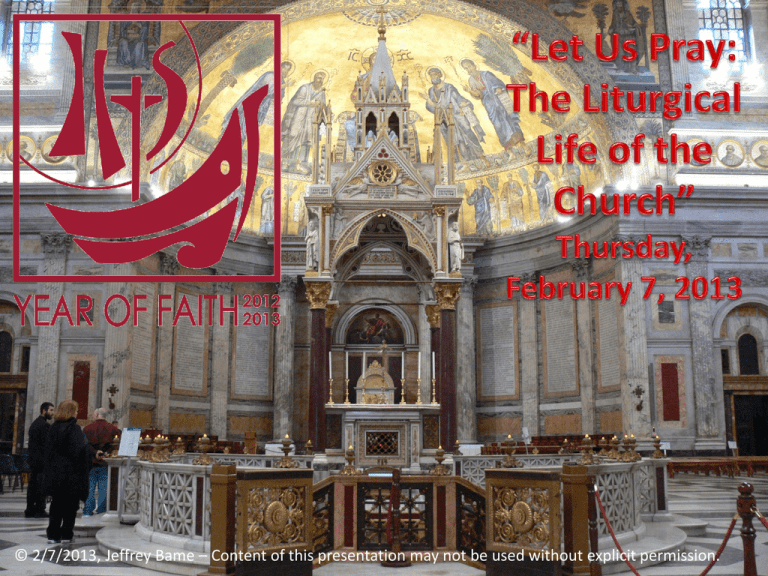
© 2/7/2013, Jeffrey Bame – Content of this presentation may not be used without explicit permission. “Let Us Pray: The Liturgical Life of the Church” Cornerstone document: The Constitution on the Sacred Liturgy: Sacrosanctum Concilium (SC) Date: December 4, 1963 English Copy: http://www.vatican.va/archive/hist_councils/ii_vatican_coun cil/documents/vat-ii_const_19631204_sacrosanctumconcilium_en.html Spanish Copy: http://www.vatican.va/archive/hist_councils/ii_vatican_coun cil/documents/vat-ii_const_19631204_sacrosanctumconcilium_sp.html Tonight’s Outline A. Sacrosanctum Concilium & The Liturgy 1. What is liturgy? 2. Vatican II Reform 3. Active Participation 4. A Breakdown of the Mass 5. Sacred Music 6. Sacred Art, Beauty, & Symbol B. Exposition of the Blessed Sacrament Pop Quiz Question 1: What does the word “liturgy” mean? Pop Quiz Answer: The Greek word λειτουργία originally meant a “public work” or “the people’s work”. In the Christian tradition it means the participation of the people in the work of God. Tonight’s Outline A. Sacrosanctum Concilium & The Liturgy 1. What is liturgy? 2. Vatican II Reform 3. Active Participation 4. A Breakdown of the Mass 5. Sacred Music 6. Sacred Art, Beauty, & Symbol B. Exposition of the Blessed Sacrament 1. What is liturgy? What it is and what it is not: “The primary and exclusive aim of the liturgy is not the expression of the individual’s reverence and worship for God. It is not even concerned with the awakening, formation, and sanctification of the individual soul as such. Nor does the onus of liturgical action and prayer rest with the collective groups, composed of numerous individuals, who periodically achieve a limited and intermittent unity in their capacity as the congregation of a church. The liturgical unity consists rather of the united body of the faithful as such – the Church – a body which infinitely outnumbers the mere congregation. The liturgy is the Church’s public and lawful act of worship…” (Guardini 19) 1. What is liturgy? “The liturgy is the summit toward which the activity of the Church is directed; at the same time it is the font from which all her power flows.” (SC 10) We celebrate the liturgy as one Church The liturgy is timeless (Ratzinger 55-57) The earthly liturgy participates in the heavenly liturgy (SC 8) “the liturgy us no mere commemoration of what once existed, but is living and real; it is the enduring life of Jesus Christ in us, and that of the believer in Christ, eternally God and Man.” (Guardini 50) 1. What is liturgy? Liturgy is not to be confused with personal prayer (Guardini 20) Liturgy stresses thought, not feeling Emotion is fleeting and unpredictable, but our thought and action can be consistent “The liturgy as a whole is not favorable to exuberance of feeling. Emotion glows in its depths, but it smolders merely, like the fiery heart of the volcano, whose summit stands out clear and serene against the quiet sky. The liturgy is emotion, but it is emotion under the strictest control.” (Guardini 25-26) 1. What is liturgy? Liturgy is not individualistic – it is about unity The liturgy does not have purpose but has meaning Humility allows us to transcend our individual spiritual existence Trying to choose the form of liturgy or worship is an subtle form of idolatry Story of the golden calf: “Worship is no longer going up to God, but drawing God down into one’s own world.” (Ratzinger 22) Tonight’s Outline A. Sacrosanctum Concilium & The Liturgy 1. What is liturgy? 2. Vatican II Reform 3. Active Participation 4. A Breakdown of the Mass 5. Sacred Music 6. Sacred Art, Beauty, & Symbol B. Exposition of the Blessed Sacrament 2. Vatican II Reform “There must be no innovations unless the good of the Church genuinely and certainly requires them; and care must be taken that any new forms adopted should in some way grow organically from forms already existing.” (SC 23) Organic development – not divorce or break The use of the vernacular New Roman Missal Priests, deacons, and lay people are not free to innovate or personalize the liturgy Pop Quiz Question 2: Christ is present in the Mass in four distinct ways. Can you name them? (Time Check 7:15) Pop Quiz Answer: 1. The Word 2. The Eucharist 3. The Priest 4. The Church (People as a whole) Tonight’s Outline A. Sacrosanctum Concilium & The Liturgy 1. What is liturgy? 2. Vatican II Reform 3. Active Participation 4. A Breakdown of the Mass 5. Sacred Music 6. Sacred Art, Beauty, & Symbol B. Exposition of the Blessed Sacrament 3. Active Participation “Mother Church earnestly desires that all the faithful should be led to that fully conscious, and active participation in liturgical celebrations which is demanded by the very nature of the liturgy. Such participation by the Christian people as "a chosen race, a royal priesthood, a holy nation, a redeemed people (1 Pet. 2:9; cf. 2:4-5), is their right and duty by reason of their baptism. In the restoration and promotion of the sacred liturgy, this full and active participation by all the people is the aim to be considered before all else; for it is the primary and indispensable source from which the faithful are to derive the true Christian spirit; and therefore pastors of souls must zealously strive to achieve it, by means of the necessary instruction, in all their pastoral work.” (SC 14) Tonight’s Outline A. Sacrosanctum Concilium & The Liturgy 1. What is liturgy? 2. Vatican II Reform 3. Active Participation 4. A Breakdown of the Mass 5. Sacred Music 6. Sacred Art, Beauty, & Symbol B. Exposition of the Blessed Sacrament 4. A Breakdown of the Mass Introductory Rites Penitential Rite Gloria Collect (Opening Prayer) Liturgy of the Word Readings Homily Creed Prayers of the Faithful 4. A Breakdown of the Mass Liturgy of the Eucharist Offertory and Preparation of the Gifts Eucharistic Prayer Thanksgiving Epiclesis Institution & Consecration Anamnesis Intercessions Doxology 4. A Breakdown of the Mass Liturgy of the Eucharist (continued) The Lord’s Prayer Sign of Peace Fraction Communion Prayer After Communion Eucharistic Prayer Concluding Rite Blessing & Dismissal Pop Quiz Question 3: How many distinct liturgical seasons does the Church celebrate (hint: Ordinary Time counts as one)? Pop Quiz Answer: Six (Ordinary Time, Advent, Christmas, Lent, Triduum, Easter) Tonight’s Outline A. Sacrosanctum Concilium & The Liturgy 1. What is liturgy? 2. Vatican II Reform 3. Active Participation 4. A Breakdown of the Mass 5. Sacred Music 6. Sacred Art, Beauty, & Symbol B. Exposition of the Blessed Sacrament 5. Sacred Music Singing is an essential part of full, active, and conscious participation Music is both personal and communal (Sing to the Lord, 2) Gregorian chant and pipe organ are to be given “pride of place” (SC 116-120) “Singing, the surpassing of ordinary speech, is a ‘pneumatic’ event.” Liturgical music is a type of “tongue” itself –a gift and charism of the Spirit. In this music, there is sober inebriation – the balance between the inspiration of the Holy Spirit and the reason and order of the Logos. (Ratzinger 140) Tonight’s Outline A. Sacrosanctum Concilium & The Liturgy 1. What is liturgy? 2. Vatican II Reform 3. Active Participation 4. A Breakdown of the Mass 5. Sacred Music 6. Sacred Art, Beauty, & Symbol B. Exposition of the Blessed Sacrament 6. Sacred Art, Beauty, & Symbol “The fine arts are rightly classed among the noblest activities of human genius; this is especially true of religious art and of its highest achievement, sacred art. Of their nature the arts are directed toward expressing in some way the infinite beauty of God in works made by human hands. They are dedicated to God, they praise him and extend his glory to the extent that their only true purpose is to turn people’s spirits devoutly toward God.” (SC 122) (Time Check 7:30) 6. Sacred Art, Beauty, & Symbol Beauty is important in places of worship – the House of the Lord should feel like a sharp contrast to the ordinary world – it should lead our hearts and minds to the mysterious and divine. Statues, images, stained glass window etc. help us to ponder divine realities Precious metals, cloth, materials add dignity to that which is set apart for a sacred purpose (vessels, vestments, etc.) Vestments - assuming a mantle Smells and bells Pop Quiz Question 4: What is the name of the colorful outer garment the priest wear while celebrating Mass? Pop Quiz Answer: The priest’s outer garment is called a chasuble. A deacon’s outer garment is called a dalmatic. Tonight’s Outline A. Sacrosanctum Concilium & The Liturgy 1. What is liturgy? 2. Vatican II Reform 3. Active Participation 4. A Breakdown of the Mass 5. Sacred Music 6. Sacred Art, Beauty, & Symbol B. Exposition of the Blessed Sacrament B. Exposition of the Blessed Sacrament The Host, Christ fully and actually present, is placed in a monstrance. Incense is used as a means of giving reverence to God and is a symbol of the sacrifice of Christians, as well as the rising prayers of the faithful Emphasis on silence and contemplation At benediction, the monstance is used to bless the people – a blessing not from a priest or deacon, but from Christ himself Adoration helps us to contemplate Christ and increase our longing to receive the Lord in Holy Communion Other Documents Referenced: USCCB – Sing to the Lord: Music in Divine Worship Romano Guardini – The Spirit of the Liturgy Joseph Ratzinger – The Spirit of the Liturgy Catechism of the Catholic Church © 2/7/2013, Jeffrey Bame – Content of this presentation may not be used without explicit permission.


